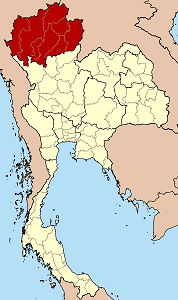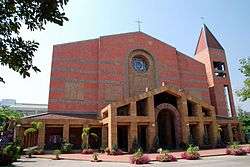Roman Catholic Diocese of Chiang Mai
| Diocese of Chiang Mai Dioecesis Chiangmaiensis สังฆมณฑลเชียงใหม่ | |
|---|---|
|
Cathedral of the Sacred Heart | |
| Location | |
| Country | Thailand |
| Ecclesiastical province | Diocese of Chiang Mai |
| Metropolitan | Bangkok |
| Statistics | |
| Area | 85,852 km2 (33,148 sq mi) |
| Population - Total - Catholics |
(as of 2014) 5,709,443 68,975 (1.2%) |
| Parishes | 47 |
| Congregations | 32 |
| Schools | 15 |
| Information | |
| Denomination | Roman Catholic |
| Sui iuris church | Latin Church |
| Rite | Roman Rite |
| Cathedral | Sacred Heart Cathedral, Chiang Mai |
| Secular priests | 94 |
| Current leadership | |
| Pope | Francis |
| Bishop | Francis Xavier Vira Arpondratana |
| Metropolitan Archbishop | Kriengsak Kovitvanit |
| Map | |
 | |
The Roman Catholic Diocese of Chiang Mai (Dioecesis Chiangmaiensis, Thai: สังฆมณฑลเชียงใหม่) in northern Thailand is a suffragan diocese of the archdiocese of Bangkok. At present, the entire Diocese of Chiang Mai is under the leadership of His Excellency Bishop Francis Xavier Vira Arpondratana.
The present Chiang Mai Diocese is composed of 8 provinces in the northern region of Thailand – Chiang Mai, Mae Hong Son, Lamphun, Chiang Rai, Phayao, Nan, Lampang and Phrae. The whole diocese covers a land area of 85,852 square kilometers with a total population of 5,709,443. As of 2014, there are already 68,975 Catholics with 15,080 Catechumens. There are 47 parishes with 519 minor churches or village chapels, 8 schools run by religious institutes, 7 diocesan schools and 760 Catholic villages. There are 94 priests, 16 religious brothers, 158 religious sisters and 819 lay catechists who work in this diocese.
History
The diocese dates back to the "Prefecture Apostolic of Chieng-Mai", which was erected on November 17, 1959. On December 18, 1965 it was elevated to a diocese.
Brief History of the Present Diocese of Chiang Mai
Amidst the pristine environment where streams flow off lofty mountain ranges into valleys and verdant green plains lies the Diocese of Chiang Mai. Its territorial extent covers all the northern provinces of Thailand, all endowed with natural resources, magnificent sceneries and the people’s own vivid local culture.
Mission to the northern territory
The long history of the diocese dates back to the time when the then Siam, old name of Thailand, granted its people the freedom to choose and practice their own religious faith. The followers of various religions were then allowed the freedom to go around and spread their own religious beliefs.
The mission to the northern region of the country started when Bishop Jean-Baptiste Pallegoix instructed Fr. Jean-Baptiste Granjean and Fr. Jean-Baptiste Vachal of the Society of Foreign Missions of Paris ( Société des Missions étrangères de Paris or M.E. P.) to take a trip to Chiang Mai for the first time on December 5, 1843. They had to travel far for a long time, spend their nights in the forests amidst all the dangers and risks from being attacked by wild beasts. It took them 45 days before they finally reached Chiang Mai on January 18, 1844. At first, they received a warm welcome from the city chief but afterwards, the city chief of Chiang Mai’s attitude changed. As a result, the two religious fathers had to abandon their mission of evangelization in the whole northern region and decided to return to Bangkok.
Years before gaining foothold
In the year 1913, Bishop Rene Perros revived the proposal to establish a center for evangelization in the northern region for another time. This task took him 1 year until in the month of January 1914 he gave this assignment to Fr. Jean-Baptiste Fouillat and Fr. Joseph Broizat, who traveled up to Chiang Mai. After exploring the area for the possibility of performing missionary activities in the area, they saw an improvement and wrote to the Bishop that the situation in Chiang Mai has significantly improved with a good atmosphere that favors the establishment of a mission center. Then they later bought a 6 hectare piece of land located in the southern part of the city near the bank of the picturesque Ping River.
Their missionary activities progressed smoothly. Hardships came along the way but they did not weaken the spirit and the zeal of these two priests in pursuing their work of evangelization.
The dream of establishing a mission center
Bishop Rene Perros’ dream was to build a catholic mission in the north and he was intent of having this dream turned into a reality even if there were many obstacles that may hamper its realization.
In the year 1930, Bishop Rene Perros requested Father George Mirabel to the mission together with a Thai priest, Father Nicholas Bunkerd Kitbamrung (who is now recognized as Blessed Nicholas Bunkerd Kitbamrung, Martyr by the Roman Catholic Church), to go and start the work of evangelization in Chiang Mai. They took the responsibility of continuing the missionary activities in the entire northern region starting first in Phitsanulok. They traveled and reached Chiang Mai on January 18, 1931 and stayed in the house of the Desousa family. It was a trip considered to be their first work of evangelization, which bore much fruits as was written in the records of the remarkable missionary activities in Chiang Mai. These two great missionaries were endowed with great faith, zeal and the ability to preach untiringly. Their work bore much fruit in spreading the Catholic faith. The missionary activities in other provinces also started to bear fruits in the 1930s.
Decades of Progress
During the late 1940s and early 1950s many religious men came to give a hand in the apostolate. Unfortunately, they stayed only for a short time as they met a lot of hardships especially at the onset of the World War II. Instead, the rest of the 1950s and 1960s were decades of remarkable progress in spreading the Catholic faith. Various religious congregations started to initiate their missionary activities. A number of Catholic schools and churches were built while parishes and areas of apostolate and pastoral work were defined. The work of evangelization reached even the mountains where the Good News was gladly welcomed by people of the hill tribes.
The Mission of Chiang Mai
On November 17, 1959, the Mission in the entire northern region was erected as the Apostolic Prefecture of Chiang Mai with Bishop Lucien Lacoste as its first bishop and head of the local church. Shortly after, the Apostolic Prefecture of Chiang Mai was elevated into a Diocese on December 18, 1965.
After the resignation of Bishop Lucien Lacoste on September 14, 1975, Bishop Robert Rattana Bamrungtrakul was installed as the head of the Diocese of Chiang Mai. Bishop Joseph Sangval Surasarang was installed in the office as the head of the diocese on January 25, 1987.
At present, the entire Diocese of Chiang Mai is under the leadership of His Excellency Bishop Francis Xavier Vira Arpondratana, who received his episcopal ordination on the 1st of May 2009.
Currently, Chiang Mai Diocese comprises eight provinces: Chiang Mai, Chiang Rai, Lamphun, Lampang, Phayao, Phrae, Nan and Mae Hong Son. Out of a total population of 5.7 million, the number of Catholics has grown to 68,975 along with 15,080 catechumens who are preparing themselves to receive the Sacrament of Baptism. 94 priests, 16 religious brothers, 153 nuns and 151 catechists work in this vast ‘vineyard’ of God.
Over the years, 518 chapels were built in the 47 parishes that comprise the entire diocese. Serving as the seat of the Catholic missions in the northern region of Thailand, the entire diocese covers a total land area of 85,852 square kilometers covering all 8 Northern provinces: Chiang Mai, Chiang Rai, Nan, Phayao, Phrae, Mae Hong Son, Lampang and Lamphun.
Cathedral
The principal church of the diocese is the Cathedral of the Sacred Heart (Thai: อาสนวิหารพระหฤทัย; Asana Wihan Phra HaRueThai; location 18°46′30.5″N 99°0′11.2″E / 18.775139°N 99.003111°E) in Chiang Mai. The current church, already the third cathedral building of the diocese, was inaugurated on October 30, 1999. The first Sacred Heart church was built in 1931. Shortly before the elevation to a diocese, a new, and larger, church was inaugurated on February 28, 1965.
The Sacred Heart College and the kindergarten school that surround the church building were added later in 2475 BE (1932 CE). Originally there were 40 students, now there are over 4,000. In the last few years an English Program has been created. This currently has just over 100 students. Each class is small, around 16 students or so, and has two teachers: a native Thai-speaking teacher and a native English-speaking teacher. Whilst Sacred Heart College is a private school, its prices are controlled by the government and are lower than international private schools in the area. Student range from pre-school up to university age.[1][2]
Bishops
- Francis Xavier Vira Arpondratana: February 10, 2009 - present
- Joseph Sangval Surasarang: October 17, 1986 - February 10, 2009 (resigned)
- Robert Ratna Bamrungtrakul: April 28, 1975 - October 17, 1986 (resigned)
- 1959-1975 the prefecture and later diocese was administrated by Bf. Lucien Bernard Lacoste, bishop of Dali.
See also
References
- ↑ https://web.archive.org/web/20090602013213/http://www.sch.ac.th/sc7.htm. Archived from the original on June 2, 2009. Retrieved June 25, 2009. Missing or empty
|title=(help) - ↑ https://translate.google.com/translate?js=n&prev=_t&hl=en&ie=UTF-8&u=http%3A%2F%2Fwww.sch.ac.th%2Fsc7.htm&sl=th&tl=en&history_state0= translation by "google translate"
External links
- Website of Chiang Mai Diocese
- catholic-hierarchy.org [self-published]
